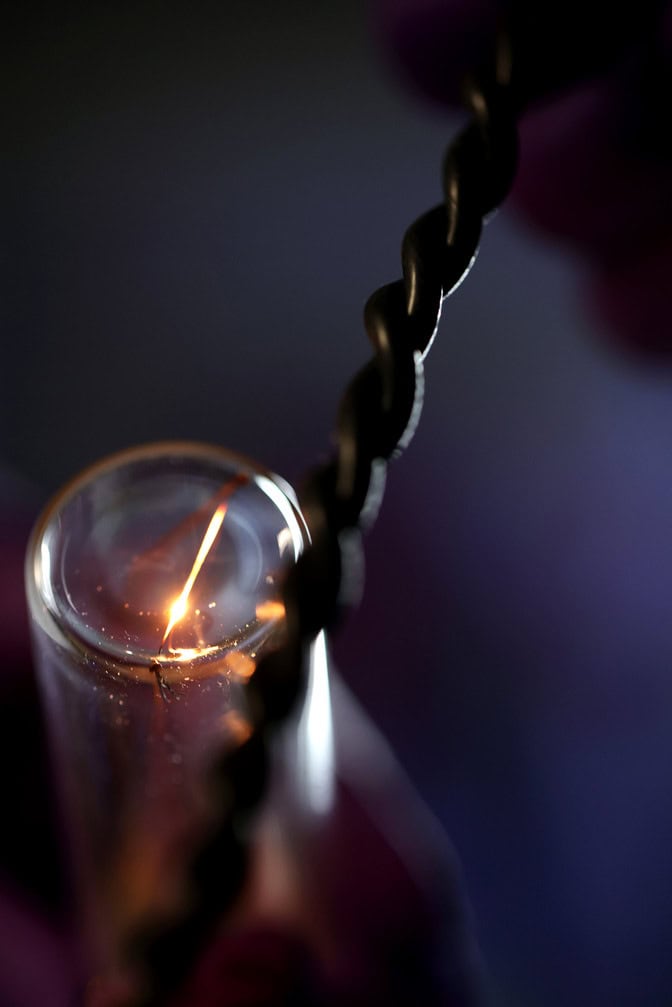
Twisted Edison: bright, elliptically polarized incandescent light
Filaments curling at the micro- and nanoscale produce light waves that twirl as they travel.

Filaments curling at the micro- and nanoscale produce light waves that twirl as they travel.
Bright, twisted light can be produced with technology similar to an Edison light bulb, researchers at the University of Michigan have shown. The finding adds nuance to fundamental physics while offering a new avenue for robotic vision systems and other applications for light that traces out a helix in space.
“It’s hard to generate enough brightness when producing twisted light with traditional ways like electron or photon luminescence,” said Jun Lu, an adjunct research investigator in chemical engineering at U-M and first author of the study on the cover of this week’s Science.
“We gradually noticed that we actually have a very old way to generate these photons—not relying on photon and electron excitations, but like the bulb Edison developed,” he added.

Every object with any heat to it, including yourself, is constantly sending out photons (particles of light) in a spectrum tied to its temperature. When the object is the same temperature as its surroundings, it is also absorbing an equivalent amount of photons—this is idealized as “blackbody radiation” because the color black absorbs all photon frequencies.
While a tungsten light bulb’s filament is much warmer than its surroundings, the law defining blackbody radiation—Planck’s law—offers a good approximation of the spectrum of photons it sends out. All together, the visible photons look like white light, but when you pass the light through a prism, you can see the rainbow of different photons within it.
This radiation is also why you show up brightly in a thermal image, but even room-temperature objects are constantly emitting and receiving blackbody photons, making them dimly visible as well.
Typically, the shape of the object emitting the radiation doesn’t get much consideration—for most purposes (as so often in physics), the object can be imagined as a sphere. But while shape doesn’t affect the spectrum of wavelengths of the different photons, it can affect a different property: their polarization.

Usually photons from a blackbody source are randomly polarized—their waves may oscillate along any axis. The new study revealed that if the emitter was twisted at the micro or nanoscale, with the length of each twist similar to the wavelength of the emitted light, the blackbody radiation would be twisted too. The strength of the twisting in the light, or its elliptical polarization, depended on two main factors: how close the wavelength of the photon was to the length of each twist and the electronic properties of the material—nanocarbon or metal, in this case.
Twisted light is also called “chiral” because the clockwise and counterclockwise rotations are mirror images of one another. The study was undertaken to demonstrate the premise of a more applied project that the Michigan team would like to pursue: using chiral blackbody radiation to identify objects. They envision robots and self-driving cars that can see like mantis shrimp, differentiating among light waves with different directions of twirl and degrees of twistedness.

“The advancements in physics of blackbody radiation by chiral nanostructures is central to this study. Such emitters are everywhere around us,” said Nicholas Kotov, the Irving Langmuir Distinguished Professor of Chemical Sciences and Engineering, the director of NSF Center of Complex Particles and Particle Systems (COMPASS), and corresponding author of the study.
“These findings, for example, could be important for an autonomous vehicle to tell the difference between a deer and a human, which emit light with similar wavelengths but different helicity because deer fur has a different curl from our fabric,” he added.
While brightness is the main advantage of this method for producing twisted light, up to 100 times brighter than other approaches, the light includes a broad spectrum of both wavelengths and twists. The team has ideas about how to address this, including exploring the possibility of building a laser that relies on twisted light-emitting structures.
Kotov also wants to explore further into the infrared spectrum. The peak wavelength of blackbody radiation at room temperature is roughly 10,000 nanometers or 0.01 millimeters.
“This is an area of the spectrum with a lot of noise, but it may be possible to enhance contrast through their elliptical polarization,” said Kotov.
The study was supported by the National Science Foundation via COMPASS, and the Office of Naval Research.
Kotov is also the Joseph B. and Florence V. Cejka Professor of Engineering, a professor of macromolecular science and engineering, and a member of U-M’s Biointerfaces Institute. Lu is an incoming assistant professor of chemistry and physics at the National University of Singapore.
The device was built in the COMPASS Lab located at the North Campus Research Complex of U-M and studied at the Michigan Center for Materials Characterization.